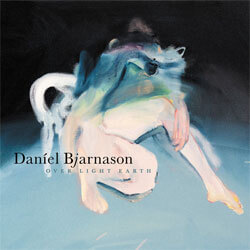 Sometimes contemporary orchestral music is abrasively radical. And sometimes the revolution is much more discreet, promising the listener a familiar language and delivering a daring lexicon. Such is the soundworld of composer Daníel Bjarnason–somehow recognizable yet ultimately elusive. As interpreted by the Reykjavík Sinfonia, the orchestral compositions featured on his second solo collection, Over Light Earth (released on September 30 by Bedroom Community), are intensely intimate while still being inherently grandiose in scope.
Sometimes contemporary orchestral music is abrasively radical. And sometimes the revolution is much more discreet, promising the listener a familiar language and delivering a daring lexicon. Such is the soundworld of composer Daníel Bjarnason–somehow recognizable yet ultimately elusive. As interpreted by the Reykjavík Sinfonia, the orchestral compositions featured on his second solo collection, Over Light Earth (released on September 30 by Bedroom Community), are intensely intimate while still being inherently grandiose in scope.

Daníel Bjarnason
While neither of the two movements of the eponymously titled composition from 2012 that begins the recording are meant to be exact interpretations of the paintings that served as impetus–Mark Rothko’s No. 9 (Dark Over Light Earth) and Jackson Pollock’s Number 1, 1949, respectively–it is the former work that is given a more literal reading. While certainly cathartic at times, Bjarnason’s music is only as effective as its quieter moments of high intensity. The first movement of the work, also called “Over Light Earth,” is distinctive for its hushed yet searing drones that dissipate almost immediately after culminating with a snarl. With only the most minimal of harmonic complements, the material is potent precisely due to the variety of textures that can be coaxed from the instruments, simply by varying timbres on one repeated note. The result is a sonic canvas that is undeniably thin but with a tightly woven fabric that maintains its integrity throughout.
“Number 1, 1949” is decidedly more mercurial. The movement opens with a vertiginous melody in the woodwinds, trailed by snickering trumpets and strings that provide a kind of aural decay in the phrases’ final notes. Bjarnason the pianist takes a more prominent role here, with expressionistic stabs at the keys that hint at concerto-like interplay. For the most part, however, the piano offers much needed rhythmic stability, particular in its upper registers. Though the music feigns repose briefly–twice in fact–the subtle violence of the rhythms, imposing entrances punctuated by accents, and the ricochet bowing in the strings all contribute to a relentless tension that never subsides. One can almost hear the lips of the Reykjavík Sinfonia brass players curl during their phrases. The movement culminates in a slurred melody in the woodwinds that plummets with a kind of harsh beauty, before returning to the general feeling of hyperactivity that began “Number 1, 1949.” Then, without warning, the music suddenly comes to a halt.
Emergence (2011) picks up where the individual movement “Over Light Earth” stopped. In “I. Silence,” a single static and foreboding harmony sets a tone of beautiful dread before bleeding into an impassioned violin melody that quivers airily above repeated swells and ceasings. Undoubtedly the most gorgeous three minutes of the album, “Silence” highlights both Bjarnason’s masterful control over few melodic and rhythmic materials and his uncanny ability to create a kind of orchestral drone that captivates despite only the slightest harmonic motion.
“II. Black Breathing” is similarly haunting, with an ideal sense of pacing. Bjarnason’s compositional timing is deliberate but exacting, as the movement evolves into insistent Stravinskyan discord circa The Rite of Spring. The overall mood brightens, ever so slightly, in “III. Emergence.” And though the drone shows no sign of dissolving, Bjarnason allows the tessitura of the violins to shimmer more, and harmonic clarity and resolve creep into the forefront. The emergence itself is one of distinctly Mahlerian flavor in the way that it revels in gravitas, and at last, in the harmonically rich closure that had eluded the work until now.
 The album closes with the comparatively older composition Solitudes, which somehow feels out of place within the context of the collection. The sprawling five-movement piano concerto from 2003 gives the listener a portrait of a gifted composer who may have been indecisive about how to channel his considerable gifts, and as a result tried to do too much.
The album closes with the comparatively older composition Solitudes, which somehow feels out of place within the context of the collection. The sprawling five-movement piano concerto from 2003 gives the listener a portrait of a gifted composer who may have been indecisive about how to channel his considerable gifts, and as a result tried to do too much.
“I. Holy” is very much in keeping with the cohesive and haunting ambiance of the entire recording, featuring a slow symphonic build that seemingly consists of one phrase stretched brilliantly over the more than two and a half minutes of the movement. From there, the piece–which includes electronics created by Valgeir Sigurðsson and Ben Frost–ranges disorientingly from prepared piano in “II. Dance Around Your Bones” to the neo-Romantic solo lines in “IV. Selge Ruh” and then back to the prepared piano in “V. T’aint No Sin.” An intriguing piece to be sure, Solitudes struggles to find its aesthetic identity, resulting in an anticlimactic ending to an album that is otherwise a stunning and definitive statement from a composer poised to make meaningful contributions to the symphonic repertoire for years to come.
Daníel Bjarnason, Over Light Earth (Bedroom Community, 2013) Buy on Amazon.com | Buy on Amazon.ca | Buy on Amazon.co.uk






















